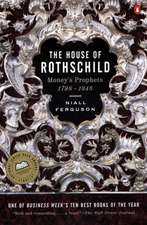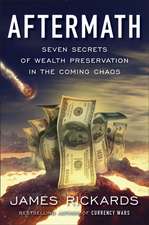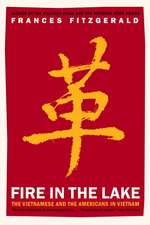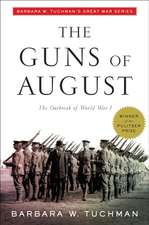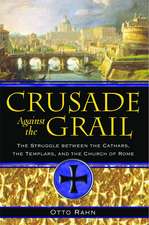The Suppressed History of American Banking: How Big Banks Fought Jackson, Killed Lincoln, and Caused the Civil War
Autor Xaviant Hazeen Limba Engleză Paperback – 19 oct 2016
In this startling investigation into the suppressed history of America in the 1800s, Xaviant Haze reveals how the powerful Rothschild banking family and the Central Banking System, now known as the Federal Reserve Bank, provide a continuous thread of connection between the War of 1812, the Civil War, the financial crises of the 1800s, and assassination attempts on Presidents Jackson and Lincoln. The author reveals how the War of 1812 began after Congress failed to renew a 20-year charter for the Central Bank. After the war, the ensuing debt forced Congress to grant the central banking scheme another 20-year charter. The author explains how this spurred General Andrew Jackson--fed up with the central bank system and Nathan Rothschild’s control of Congress--to enter politics and become president in 1828. Citing the financial crises engineered by the banks, Jackson spent his first term weeding out Rothschild agents from the government. After being re-elected to a 2nd term with the slogan “Jackson and No Bank,” he became the only president to ever pay off the national debt. When the Central Bank’s charter came up for renewal in 1836, he successfully rallied Congress to vote against it.
Preț: 93.44 lei
Nou
Puncte Express: 140
Preț estimativ în valută:
17.88€ • 18.56$ • 14.91£
17.88€ • 18.56$ • 14.91£
Carte disponibilă
Livrare economică 01-15 martie
Preluare comenzi: 021 569.72.76
Specificații
ISBN-13: 9781591432333
ISBN-10: 1591432332
Pagini: 240
Ilustrații: 79 b&w illustrations
Dimensiuni: 152 x 229 x 20 mm
Greutate: 0.39 kg
Editura: Inner Traditions/Bear & Company
Colecția Bear & Company
ISBN-10: 1591432332
Pagini: 240
Ilustrații: 79 b&w illustrations
Dimensiuni: 152 x 229 x 20 mm
Greutate: 0.39 kg
Editura: Inner Traditions/Bear & Company
Colecția Bear & Company
Notă biografică
Xaviant Haze is a researcher of ancient manuscripts and alternative history, exploring and documenting his findings on lost cities and the myths of the pre-diluvian world. The coauthor of The Suppressed History of America, he lives in South Beach, Florida.
Extras
Abraham Lincoln Discovers the Truth
1862-1865
The war years of 1862 and 1863 were tough on the president as the cost of the war was sinking the nation into abstract bankruptcy. With no alternative he was forced to seek financial aid from the Rothschilds. They welcomed Lincoln with open arms and open wallets. His giant stature and immediate charisma was duly noted by the bankers as they dined on beef stroganoff and toasted to their forefathers and the end of the war. But the Rothschilds weren’t interested in ending the war, at least not until their central bank had been rechartered. A topic they discussed with passion as they laid the terms of the deal out to a heavyhearted Lincoln.
They agreed to provide Lincoln the currency he needed at 35 percent interest on all monies loaned as long as they were allowed a new charter for another United States central bank. Lincoln held a poker face during the meeting, and once it ended told them that he would be in touch. What he did next angered the Rothschilds and pretty much sealed his fate. Recognizing the Rothschild’s scam and furious over the high level of interest they attempted to charge him, Lincoln made the boldest presidential move yet--he printed his own debt-free money. Called “the greenback,” it was the prototype for modern American currency.
Lincoln’s friend Colonel Edmund Dick Taylor had mentioned the idea of creating a new currency in order to pay for the war. Taylor was well versed in Rothschild economics and had made a fortune in the coal-mining business. He, like a lot of northerners in 1863, was worried that the South might actually win. Based on Taylor’s suggestions Lincoln intentionally insulted the Rothschilds by authorizing Congress to print the greenbacks as full legal treasury tender. Lincoln flooded the economy with 450 million dollars, which was distinguished from all other currencies by the green ink on the back of the bills. The money was a godsend as soldiers got paid and the economy boomed. Though Lincoln was greatly concerned at having to issue fiat-based currency backed by nothing, he declared, “We gave the people of this republic the greatest blessing they ever had, their own paper money to pay their own debts.”
As the Rothschilds fumed over being betrayed, Lincoln introduced state loans void from the bankers’ clutches, financing the Civil War on state-issued credit. Fearing a wicked response, Lincoln slept with one eye open as he fought the bankers over the greenbacks and a proposed American national banking system. He also freed the slaves with his “Emancipation Proclamation,” a move that infuriated the Rothschilds and crippled the South’s economic future. But Lincoln couldn’t truly escape the Rothschilds, at least not when it came to money. His personal banker, Jay Cooke, was hired to sell small government bonds to the average citizen, but instead he sold them in London and hired over 2,500 sub-agents who hawked over a billion dollars’ worth of bonds in three years. Cooke was later forced to pay the treasury back after getting caught backroom dealing with the Rothschilds and J. P. Morgan. But as reelection time neared Lincoln had control over both Congress and America’s banking system as he enacted the Rothschild counter measure called the National Bank and Currency Acts of 1863 and 1864. Lincoln’s measures included a nationally regulated private banking system intent on issuing cheap credit to build industries non-reliant on the southern plantation system.
Lincoln’s financial reform plans were working. The money changers in London were furious, and furthermore the war efforts on behalf of their southern investments weren’t panning out either as new industrial inventions began to obliterate the South’s chances of winning. To combat Lincoln’s paper-money experiment and the impending end of the Civil War, the Rothschilds surrounded America’s borders with foreign troops waiting to swoop in and finish off their wounded foe with a planned military invasion. The British were situated up north in Canada with over 11,000 troops waiting to invade New York, while both France and Spain had united in Mexico with another 30,000 soldiers willing to carve up America on the Rothschild’s bidding. But the money masters’ intricately planned two-pronged attack was thwarted by Tsar Alexander II of Russia, the only European monarch not indebted to the Rothschilds banking empire.
Russia shared a good economic relationship with America, which inspired them to end serfdom and emulate the American practice of private farming. Russia even copied the modern construction methods of the U.S. Navy and by 1864 had built the third largest fleet of ships in the world, trailing only behind Britain and France. When Lincoln learned that Tsar Alexander II also rejected the Rothschilds’ continual attempts to set up a central bank in Russia, he saw that the two leaders were in the same boat, and so he asked for the Tsar’s help during the Civil War. The Tsar obliged and sent his fleet across the Atlantic with a specific warning to the Rothschilds that an attack on America would be considered an attack on Russia as well.
The Tsar’s Russian fleet steamed into New York Harbor on September 24, 1863, while his Pacific fleet anchored in San Francisco a few weeks later. Lincoln’s secretary of the Navy, Gideon Wells, wrote in his diary, “They arrived at the high tide of the Confederacy and the low tide of the North, causing England and France to hesitate long enough to turn the tide for the North.”3 This deliberate naval move by the Tsar and his Russian fleet prevented France and Britain from carrying out their invasion plans as the Rothschilds weren’t ready to risk war with Russia. The British and French troops amassed on America’s borders waited in vain to repossess the wealth of the colonies, but while they waited their moment slipped away as the war ended and Lincoln was declared the victor.
1862-1865
The war years of 1862 and 1863 were tough on the president as the cost of the war was sinking the nation into abstract bankruptcy. With no alternative he was forced to seek financial aid from the Rothschilds. They welcomed Lincoln with open arms and open wallets. His giant stature and immediate charisma was duly noted by the bankers as they dined on beef stroganoff and toasted to their forefathers and the end of the war. But the Rothschilds weren’t interested in ending the war, at least not until their central bank had been rechartered. A topic they discussed with passion as they laid the terms of the deal out to a heavyhearted Lincoln.
They agreed to provide Lincoln the currency he needed at 35 percent interest on all monies loaned as long as they were allowed a new charter for another United States central bank. Lincoln held a poker face during the meeting, and once it ended told them that he would be in touch. What he did next angered the Rothschilds and pretty much sealed his fate. Recognizing the Rothschild’s scam and furious over the high level of interest they attempted to charge him, Lincoln made the boldest presidential move yet--he printed his own debt-free money. Called “the greenback,” it was the prototype for modern American currency.
Lincoln’s friend Colonel Edmund Dick Taylor had mentioned the idea of creating a new currency in order to pay for the war. Taylor was well versed in Rothschild economics and had made a fortune in the coal-mining business. He, like a lot of northerners in 1863, was worried that the South might actually win. Based on Taylor’s suggestions Lincoln intentionally insulted the Rothschilds by authorizing Congress to print the greenbacks as full legal treasury tender. Lincoln flooded the economy with 450 million dollars, which was distinguished from all other currencies by the green ink on the back of the bills. The money was a godsend as soldiers got paid and the economy boomed. Though Lincoln was greatly concerned at having to issue fiat-based currency backed by nothing, he declared, “We gave the people of this republic the greatest blessing they ever had, their own paper money to pay their own debts.”
As the Rothschilds fumed over being betrayed, Lincoln introduced state loans void from the bankers’ clutches, financing the Civil War on state-issued credit. Fearing a wicked response, Lincoln slept with one eye open as he fought the bankers over the greenbacks and a proposed American national banking system. He also freed the slaves with his “Emancipation Proclamation,” a move that infuriated the Rothschilds and crippled the South’s economic future. But Lincoln couldn’t truly escape the Rothschilds, at least not when it came to money. His personal banker, Jay Cooke, was hired to sell small government bonds to the average citizen, but instead he sold them in London and hired over 2,500 sub-agents who hawked over a billion dollars’ worth of bonds in three years. Cooke was later forced to pay the treasury back after getting caught backroom dealing with the Rothschilds and J. P. Morgan. But as reelection time neared Lincoln had control over both Congress and America’s banking system as he enacted the Rothschild counter measure called the National Bank and Currency Acts of 1863 and 1864. Lincoln’s measures included a nationally regulated private banking system intent on issuing cheap credit to build industries non-reliant on the southern plantation system.
Lincoln’s financial reform plans were working. The money changers in London were furious, and furthermore the war efforts on behalf of their southern investments weren’t panning out either as new industrial inventions began to obliterate the South’s chances of winning. To combat Lincoln’s paper-money experiment and the impending end of the Civil War, the Rothschilds surrounded America’s borders with foreign troops waiting to swoop in and finish off their wounded foe with a planned military invasion. The British were situated up north in Canada with over 11,000 troops waiting to invade New York, while both France and Spain had united in Mexico with another 30,000 soldiers willing to carve up America on the Rothschild’s bidding. But the money masters’ intricately planned two-pronged attack was thwarted by Tsar Alexander II of Russia, the only European monarch not indebted to the Rothschilds banking empire.
Russia shared a good economic relationship with America, which inspired them to end serfdom and emulate the American practice of private farming. Russia even copied the modern construction methods of the U.S. Navy and by 1864 had built the third largest fleet of ships in the world, trailing only behind Britain and France. When Lincoln learned that Tsar Alexander II also rejected the Rothschilds’ continual attempts to set up a central bank in Russia, he saw that the two leaders were in the same boat, and so he asked for the Tsar’s help during the Civil War. The Tsar obliged and sent his fleet across the Atlantic with a specific warning to the Rothschilds that an attack on America would be considered an attack on Russia as well.
The Tsar’s Russian fleet steamed into New York Harbor on September 24, 1863, while his Pacific fleet anchored in San Francisco a few weeks later. Lincoln’s secretary of the Navy, Gideon Wells, wrote in his diary, “They arrived at the high tide of the Confederacy and the low tide of the North, causing England and France to hesitate long enough to turn the tide for the North.”3 This deliberate naval move by the Tsar and his Russian fleet prevented France and Britain from carrying out their invasion plans as the Rothschilds weren’t ready to risk war with Russia. The British and French troops amassed on America’s borders waited in vain to repossess the wealth of the colonies, but while they waited their moment slipped away as the war ended and Lincoln was declared the victor.
Cuprins
1 The Forgotten War of 1812
2 The Rothschilds Win Again 1815-1825
3 Andrew Jackson Steps into the Arena 1826-1831
4 Battling the Seven-Headed Hydra 1832-1835
5 Jackson Kills the Bank 1836-1846
6 Ancient Giants and Westward Expansion 1847-1857
7 The Rothschilds and the Civil War 1858-1861
8 Abraham Lincoln Discovers the Truth 1862-1865
9 Assassin’s Creed: John Wilkes Booth 1865-?
Appendix
President Jackson’s Veto Message Regarding the Bank of the United States July 10, 1832
Notes
Bibliography
Index
2 The Rothschilds Win Again 1815-1825
3 Andrew Jackson Steps into the Arena 1826-1831
4 Battling the Seven-Headed Hydra 1832-1835
5 Jackson Kills the Bank 1836-1846
6 Ancient Giants and Westward Expansion 1847-1857
7 The Rothschilds and the Civil War 1858-1861
8 Abraham Lincoln Discovers the Truth 1862-1865
9 Assassin’s Creed: John Wilkes Booth 1865-?
Appendix
President Jackson’s Veto Message Regarding the Bank of the United States July 10, 1832
Notes
Bibliography
Index
Recenzii
“I can say with enthusiasm that this is one of the best high overviews of the subject I have read.”
“Very smart people always say if you want to discover the truth about almost anything, ‘follow the money!’ Well, if you want to discover some truth about money in America, read Xaviant Haze’s The Suppressed History of American Banking!”
“Excellent history and research by Xaviant Haze. It is rare to find someone who takes the time to discover true history. This book puts so much into perspective. I am grateful to Xaviant for bringing all of this information to public knowledge.”
The old adage "follow the money" rings true in this second book in the Suppressed History series by Xaviant Haze (the first with co-author Paul Schrag). The theme running through is the role of the powerful Rothschild banking family from the post–American Revolution days to the end of the Civil War. From working behind the scenes with King George III to funding the 1812-14 war on America, fomenting economic crises and sponsoring both sides of the Civil War, the Rothschilds went all out to get their own way.
Yet this is also the story of those who stood up to them. Andrew Jackson, for example, was elected President in 1828 and spent his early days in office weeding out Rothschild agents. In 1835, as Jackson fought the Second Bank of America, the Rothschild family paid a mentally unstable man to assassinate him, but the bid failed. In 1865, another Rothschild hired hand, the actor John Wilkes Booth, succeeded in assassinating President Lincoln who had riled the banking family by having state banks issue "greenbacks". The Rothschilds, Haze writes, conspired to destroy what was a successful monetary system, creating yet another recession and exerting more control over the people.
The sub-theme of Haze's book is the discovery over the decades of giant skeletons, reported in the press of the day, and the interest of several Presidents in the subject. It's an intriguing book with a treasure-trove of archival images.
“Very smart people always say if you want to discover the truth about almost anything, ‘follow the money!’ Well, if you want to discover some truth about money in America, read Xaviant Haze’s The Suppressed History of American Banking!”
“Excellent history and research by Xaviant Haze. It is rare to find someone who takes the time to discover true history. This book puts so much into perspective. I am grateful to Xaviant for bringing all of this information to public knowledge.”
The old adage "follow the money" rings true in this second book in the Suppressed History series by Xaviant Haze (the first with co-author Paul Schrag). The theme running through is the role of the powerful Rothschild banking family from the post–American Revolution days to the end of the Civil War. From working behind the scenes with King George III to funding the 1812-14 war on America, fomenting economic crises and sponsoring both sides of the Civil War, the Rothschilds went all out to get their own way.
Yet this is also the story of those who stood up to them. Andrew Jackson, for example, was elected President in 1828 and spent his early days in office weeding out Rothschild agents. In 1835, as Jackson fought the Second Bank of America, the Rothschild family paid a mentally unstable man to assassinate him, but the bid failed. In 1865, another Rothschild hired hand, the actor John Wilkes Booth, succeeded in assassinating President Lincoln who had riled the banking family by having state banks issue "greenbacks". The Rothschilds, Haze writes, conspired to destroy what was a successful monetary system, creating yet another recession and exerting more control over the people.
The sub-theme of Haze's book is the discovery over the decades of giant skeletons, reported in the press of the day, and the interest of several Presidents in the subject. It's an intriguing book with a treasure-trove of archival images.
Descriere
Reveals how the Rothschild Banking Dynasty fomented war and assassination attempts on 4 presidents in order to create the Federal Reserve Bank.

